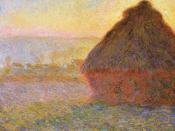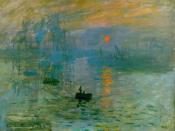In the late 19th century, a new artistic movement started to emerge in the art world in France; this influential shift is named Impressionism. This movement pays its most recognition to many Impressionists, a group of French artists such as: Paul Cezane, Edgar Degas, Edouard Manet, Claude Monet, Camille Pissarro, Auguste Renoir, and so many more. Art works by these painters give viewers a totally fresh perception and interpretation of art, which is the immediate sensation or impression produced by the painting's everyday scenes of landscape or scenes of modern life. The art work that I have chosen to represent is one of many admirable paintings from Claude-Oscar Monet, a famous and influential artist who is considered, by many art historians, to be the leader of the French Impressionist movement. It is a painting of Monet's own house and garden during his time at Vetheuil from the early 1880's.
Despite its simple depiction of an everyday scene, "Artist's Garden at Vetheuil" immediately attracts my attention through Monet's skills in choosing the subject matter, techniques, and colors. It is an enjoyment gazing at this beautiful natural scene. How did Monet manage to capture Nature, or in other words, bring Nature into Art, through "Artist's Garden at Vetheuil?"
The first and most correct answer for the question above is Monet's choice of subjects. In the book Nature into Art, author John House explains that impressionists often chose to depict the "real" world or whatever they saw around them (15). He further explains that during the 1880's, Monet became completely occupied with raw nature (15). He had come to love those everyday scenes of nature such as foliage, flowers, waves, and rocks. The pictorial possibilities of these scenes, and also the effect of light and atmosphere on them fascinated him tremendously (15).


